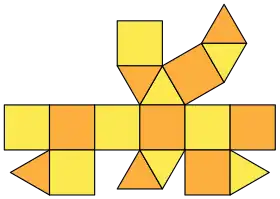Square orthobicupola
In geometry, the square orthobicupola is one of the Johnson solids (J28). As the name suggests, it can be constructed by joining two square cupolae (J4) along their octagonal bases, matching like faces. A 45-degree rotation of one cupola before the joining yields a square gyrobicupola (J29).
| Square orthobicupola | |
|---|---|
 | |
| Type | Johnson J27 – J28 – J29 |
| Faces | 8 triangles 2+8 squares |
| Edges | 32 |
| Vertices | 16 |
| Vertex configuration | 8(32.42) 8(3.43) |
| Symmetry group | D4h |
| Dual polyhedron | - |
| Properties | convex |
| Net | |
 | |
A Johnson solid is one of 92 strictly convex polyhedra that is composed of regular polygon faces but are not uniform polyhedra (that is, they are not Platonic solids, Archimedean solids, prisms, or antiprisms). They were named by Norman Johnson, who first listed these polyhedra in 1966.[1]
The square orthobicupola is the second in an infinite set of orthobicupolae.
The square orthobicupola can be elongated by the insertion of an octagonal prism between its two cupolae to yield a rhombicuboctahedron, or collapsed by the removal of an irregular hexagonal prism to yield an elongated square dipyramid (J15), which itself is merely an elongated octahedron.
It can be constructed from the disphenocingulum (J90) by replacing the band of up-and-down triangles by a band of rectangles, while fixing two opposite sphenos.
Related polyhedra and honeycombs
The square orthobicupola forms space-filling honeycombs with tetrahedra; with cubes and cuboctahedra; with tetrahedra and cubes; with square pyramids, tetrahedra and various combinations of cubes, elongated square pyramids and/or elongated square bipyramids.[2]
References
- Johnson, Norman W. (1966), "Convex polyhedra with regular faces", Canadian Journal of Mathematics, 18: 169–200, doi:10.4153/cjm-1966-021-8, MR 0185507, Zbl 0132.14603.
- "J28 honeycomb".